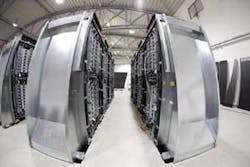OnPATH Technologies (www.onpathtech.com), whose automated solutions are designed to enable companies to virtualize their physical infrastructure layer, says a potentialdata center construction boom could prove problematic in the long rununless the physical network infrastructure is carefully considered beforehand.
The company’s assessment is in response to recent research from Campos Research (campos.com) that indicate up to 50% of surveyrespondents plan to eitherexpand or build new data centers over the next two years. Lack ofspace, power inefficiencies, and increasing disaster recovery needs are cited as the main reasons for expansion plans.
Data centers, such as this one featuring Europe’s most powerful computer in Julich, Germany, may be able to achieve increased longevity and usefulness by instituting virtualization technologies.
"It’s a problem we continually see—data centers reach the capacity limit of their physical network infrastructure, which is then further exacerbated by planned and unplanned moves, adds, and changes of cables and equipment," says Peter Dougherty, president and CEO of OnPATH Technologies, a Layer 1 connectivity solutionsdeveloper. "Over time, a rat’s nest ofoptical and copper networks isinevitably created, and companies face the reality of building a new data center or investing even more resourcesinto a bigger version of the same model."
But Dougherty says both are done "without considering the root issue—and it all can be avoided if the physicallayer network infrastructure is prop-erly addressed in the planning stages."
With cost and ROI issues top-of-mind with executives, Dougherty cautions that network infrastructure and data center expansion involves more than just the direct costs of new buildings and equipment. "Time to deployment, time to market, cost of downtime, migration time, re-testing, and the impact on worker productivity needs to be accounted for," he explains. "It’s obvious that the price of power and real estate is going to continue to increase, so the longer a data center can be efficiently operated, the greater return on investment companies will see."
Better planning and attention to the virtualization of the physical infrastructure layer, Dougherty suggests, canextend the data center lifecycle by helping to reduce power, cooling, and space needs while improving network automation, asset management, time to market, system testing and disaster recovery.
"So much emphasis has been placed on the virtualization of applications, servers, storage, etc., but companies often don’t consider that they will hit the wall in terms of the physical network connectivity needed to keep all that virtualized equipment running efficiently," explains Dougherty. "Unstructured optical and copper cabling is unreliable, and connector and wiring failures will drive upoperating costs by physically limiting the ability to scale and consolidate.Unfortunately, what most people do not realize is that studies have shown that a majority of network downtime is due to cabling problems."
OnPATH Technologies providesLayer 1 switching solutions that automate and virtualize connectivity, helping organizations simplify their physical layer infrastructure to improve the availability, manageability, and performance of their data center environments. The company says that by virtualizing the physical network layer, data centers achieve end-to-end virtualization that can ultimately pave the way for next generation networks, helping to reduce operation costs, provide an agile and real-time infrastructure, and support green initiatives.
Dougherty says companies should consider integrating a virtualized physical layer as part of the groundwork for a longer data center lifecycle. Despite the current sluggish economic conditions, he cautions, the pressure for expansion plans and the need to handle more data efficiently and securely will not be going away.
"Over the last decade, the pace of IT advancement moved so quickly that the focus was on deploying equipment and applications," Dougherty says. "Today, it has turned to saving money, increasing efficiency and agility, and extending the life of the infrastructure. Every C-level executive and network operations professional should understand how significantly the physical layer of their network impacts overall operations and how smart planning and implementation of a virtualized network infrastructure can benefit them through multiple generations of technology investments."
